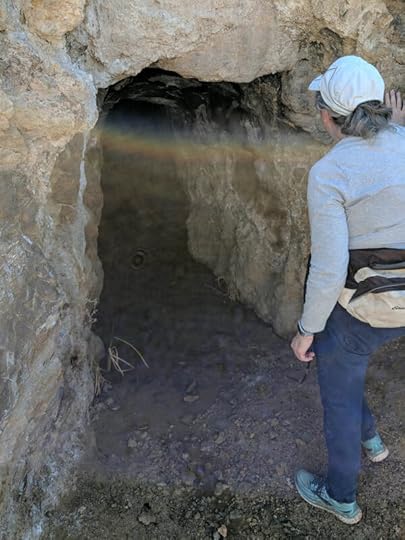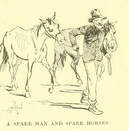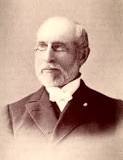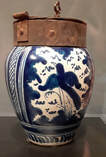Jennifer Bohnhoff's Blog, page 33
March 28, 2019
Blueberry Muffins
 Have you been following my monthly manic muffin posts? I started with a basic muffin mix that you can make up ahead of time. Each month so far I've offered a variation on the basic muffin: chocolate cherry in February, and corned beef and spinach in March.
Have you been following my monthly manic muffin posts? I started with a basic muffin mix that you can make up ahead of time. Each month so far I've offered a variation on the basic muffin: chocolate cherry in February, and corned beef and spinach in March.This week I added 1 cup of blueberries to the basic recipe, and they were yummy!
This coming Monday I'll post a spring version of manic muffins that will work well as part of your Easter brunch menu, so keep your eye out for it!
Published on March 28, 2019 08:10
March 25, 2019
A Walk Through History
 All pictures (with the exception of the live crinoid) by Heather Patrick. Last week I got a chance to hike with my sister Heather in the Sacramento Mountains, east of Alamogordo, New Mexico. Alamogordo is 200 miles south of my home, and its season is weeks ahead; while it is still cold and snowy in my Sandias, the Sacramentos were balmy. The sky was blue, the birds sang, the sweeping vistas spectacular, but what really made the hike memorable is that it was a walk through time that stretched way, way back.
All pictures (with the exception of the live crinoid) by Heather Patrick. Last week I got a chance to hike with my sister Heather in the Sacramento Mountains, east of Alamogordo, New Mexico. Alamogordo is 200 miles south of my home, and its season is weeks ahead; while it is still cold and snowy in my Sandias, the Sacramentos were balmy. The sky was blue, the birds sang, the sweeping vistas spectacular, but what really made the hike memorable is that it was a walk through time that stretched way, way back.It's hard to envision now, but this arid land was once very different. Between 358 and 323 million years ago, it was part of a vast ocean. Much of the limestone in the Sacramentos is studded with fossils that prove that the area was underwater. I saw lots of shells and shell imprints, but especially prevalent were the fossilized stems of crinoids, which look like stacked rock coins. Although they look like little palm trees, crinoids are animals, not plants. They are still alive today, but they are hard to see since they live at great depths.



 Looking west, we could see straight across the Tularosa Basin to the San Andreas mountains, about 60 miles away. Once, these two mountain ranges were contiguous. The land in between has dropped.
Looking west, we could see straight across the Tularosa Basin to the San Andreas mountains, about 60 miles away. Once, these two mountain ranges were contiguous. The land in between has dropped.Can you see the white line that seems to extend from the bill of my cap? That's the gypsum sands at White Sands National Monument.
 Moving up the trail brought us forward in time. While walking along an arroyo, we saw these pock marked rocks. Although these were the only ones I saw on the hike, my sister tells me there are many of these in the area, and they are not naturally formed. Because water tends to collect in them, these depressions are called Indian wells. (The parking lot at the trail head is at the end of Indian Wells Road.)
Moving up the trail brought us forward in time. While walking along an arroyo, we saw these pock marked rocks. Although these were the only ones I saw on the hike, my sister tells me there are many of these in the area, and they are not naturally formed. Because water tends to collect in them, these depressions are called Indian wells. (The parking lot at the trail head is at the end of Indian Wells Road.)A sign at Oliver Lee State Park, which is not far south of this trail, explains that these depressions weren't originally used for collecting water. Instead, they mark places where Indians ground up nuts and grains ground up. They are more like mortars than wells.

 Farther up the trail, in a narrow side canyon, we came upon something that I've never seen in a mountainous desert setting before: cattails. The cattails were in front of a cave that my sister tells me is a spring visited by Indians since time immemorial. There was about a foot of standing water in the cave, which seemed to stretch far into the mountain. This water source, so valuable in the arid southwest, has obviously been used by more modern man; on our way down the canyon we saw several lengths of rusted pipe and the derelict remains of an old water tower.
Farther up the trail, in a narrow side canyon, we came upon something that I've never seen in a mountainous desert setting before: cattails. The cattails were in front of a cave that my sister tells me is a spring visited by Indians since time immemorial. There was about a foot of standing water in the cave, which seemed to stretch far into the mountain. This water source, so valuable in the arid southwest, has obviously been used by more modern man; on our way down the canyon we saw several lengths of rusted pipe and the derelict remains of an old water tower.
 It was a lovely hike on a lovely day, and it was a reminder that there is interesting things to looks at wherever you go. History and geology, archaeology and botany are right under your feet, and beneath them, if you use your imagination, are story prompts enough to last a long, long while.
It was a lovely hike on a lovely day, and it was a reminder that there is interesting things to looks at wherever you go. History and geology, archaeology and botany are right under your feet, and beneath them, if you use your imagination, are story prompts enough to last a long, long while.
 Jennifer Bohnhoff is a writer and hiker who lives in central New Mexico.
Jennifer Bohnhoff is a writer and hiker who lives in central New Mexico. Click here if you want to learn more about the geology of the Sacramento Mountains.
Click here if you want to learn more about Jennifer and her books.
Published on March 25, 2019 00:00
March 6, 2019
What to do with a bit of leftover Corned Beef
Earlier this week I posted a recipe for muffins that used some corned beef. Here's a way to use up the rest of that can. You could dice up leftover corned beef from St. Patrick's Day and use it instead of canned meat and you'd still get a great meal - warm and comforting on a cold winter's night.
One of the nice things about this recipe is that the ingredients are all shelf-stable or things you would commonly have around the house. That means that you can throw it together even when there's a snowstorm and you can't go to the store. This recipe was my mother's, and it was one of my favorite comfort foods growing up.
Corned Beef and Cheese Pie 1 unbaked pie shell
12 oz (or less, if that's all you have) canned corned beef
e eggs
1 1/2 c. undiluted evaporated milk
1 TBS instant minced onion (or fresh onion, diced small)
1 tsp mustard
dash black pepper
dash tabasco
1 c. shredded sharp cheddar cheese
1 tsp dried or fresh parsley
Spread corned beef in bottom of pie shell.
Mix together next seven items. Stir in cheese.
Pour cheese mixture over corned beef. Sprinkle with parsley.
Bake in a 375 degree oven for 40 minutes, until firm.
Cut in wedges and serve warm. Serves 6.

One of the nice things about this recipe is that the ingredients are all shelf-stable or things you would commonly have around the house. That means that you can throw it together even when there's a snowstorm and you can't go to the store. This recipe was my mother's, and it was one of my favorite comfort foods growing up.
Corned Beef and Cheese Pie 1 unbaked pie shell
12 oz (or less, if that's all you have) canned corned beef
e eggs
1 1/2 c. undiluted evaporated milk
1 TBS instant minced onion (or fresh onion, diced small)
1 tsp mustard
dash black pepper
dash tabasco
1 c. shredded sharp cheddar cheese
1 tsp dried or fresh parsley
Spread corned beef in bottom of pie shell.
Mix together next seven items. Stir in cheese.
Pour cheese mixture over corned beef. Sprinkle with parsley.
Bake in a 375 degree oven for 40 minutes, until firm.
Cut in wedges and serve warm. Serves 6.

Published on March 06, 2019 00:00
March 4, 2019
Savory Muffins for a Winter's Day
 MMMM. Muffins. They are warming comfort food on a cold winter's day. But they don't have to be sweet. Muffins can come in savory varieties, too.
MMMM. Muffins. They are warming comfort food on a cold winter's day. But they don't have to be sweet. Muffins can come in savory varieties, too.Most people associate muffins with breakfast. A savory muffin can be a great breakfast treat. I think it would be great split, toasted, and topped with a poached egg. But savory muffins can serve well beyond breakfast. A savory muffin can be a great accompaniment to a cup of soup at lunch, like in the picture, which it's served with tomato soup and cream cheese-stuffed celery. It packs to sell that it can be an easy snack at your desk in the middle of the afternoon, or a nice way to complement a glass of wine in the evening. Make them in tiny muffin tins and the become great appetizers! I began a monthly series on muffins back in January, beginning with a recipe for a muffin mix that would make a manic Monday morning a little easier to swallow. In February I offered a variation on the basic muffin that gave a nod to the two big holidays of the month, Valentine's and President's Day. You can find that basic muffin mix and recipe here, and the cherry chocolate version here.
Inspired by St. Patrick's Day, March's muffin variation is a savory one made with cheddar cheese, corned beef, and spinach. The nutmeg that's in the original mix complements the spinach well and makes the kitchen smell warm and inviting when the muffins are in the oven. Try them! You just might be searching for ways to eat them all day long.
 Corned Beef and Spinach Muffins Preheat oven to 350.
Corned Beef and Spinach Muffins Preheat oven to 350.Mix together in a mixing bowl
2 eggs
3/4 cup water
1/2 cup oil
1 TBS mustard
1/4 cup frozen, chopped spinach, thawed and squeezed dry
1/2 cup shredded cheddar cheese
1/2 cup canned corned beef, broken up with a fork
Add and stir until there are no dry lumps
2 3/4 cups of Manic Muffin Mix
Line muffin tins with papers. Fill cups 3/4 full with batter. Bake 20-22 minutes, or until golden brown. Not sure how to squeeze spinach dry? I poured the frozen spinach into a measuring cup and thawed it in the microwave, then pressed on it with the back of a spoon, pouring the excess water into the sink.
Don't know what to do with the leftover corned beef? I'll have another recipe later this week that will use it up.
 Jennifer Bohnhoff is a Middle School English teacher and the author of 7 published novels, which you can learn more about here. But a girl's gotta eat, too, so she publishes recipes on occasion.
Jennifer Bohnhoff is a Middle School English teacher and the author of 7 published novels, which you can learn more about here. But a girl's gotta eat, too, so she publishes recipes on occasion.
Published on March 04, 2019 00:00
February 25, 2019
The Army mule in time of peace.
 That men are ungrateful can plainly be seen
That men are ungrateful can plainly be seenIn the case of that mule standing out on the green.
His features are careworn, bowed down is his head,
His spirit is broken: his hopes have all fled.
He thinks of the time when the battle raged sore,
When he mingled his bray with the cannon's loud roar;
When Uncle Sam's soldiers watched for him to come,
Hauling stores of provisions and powder and rum;
When his coming was greeted with cheers and huzzas,
And the victory turned on the side of the stars.
These thoughts put new life into rickety bones-
He prances just once, then falls over and groans.
A vision comes over his poor mulish mind,
And he sees Uncle Sam, with his agents behind,
Granting pensions by thousands to all who apply,
From the private so low to the officer high;
To the rich and the poor, the wise man and fool,
But, alas! there is none for the “poor army mule.”
Taken from John D. Billings, Hardtack and Coffee: The Unwritten Story of Army Life
 Jennifer Bohnhoff is the author of two novels set during the American Civil War: The Bent Reed takes place at Gettysburg, and Valverde is set in New Mexico Territory. She is currently at work on a sequel to Valverde which will cover the Battle of Glorieta, which has been called the Gettysburg of the West.
Jennifer Bohnhoff is the author of two novels set during the American Civil War: The Bent Reed takes place at Gettysburg, and Valverde is set in New Mexico Territory. She is currently at work on a sequel to Valverde which will cover the Battle of Glorieta, which has been called the Gettysburg of the West.
Published on February 25, 2019 00:00
February 23, 2019
For the Late Bloomers
 My New Year's Eve blog was about a valiant little amaryllis that began blooming too early. I deemed it crippled for life and hopeless, but was inspired by its tenacity in the face of impossible odds. You can read that first blog by clicking on the picture.
My New Year's Eve blog was about a valiant little amaryllis that began blooming too early. I deemed it crippled for life and hopeless, but was inspired by its tenacity in the face of impossible odds. You can read that first blog by clicking on the picture.The little flower surprised me. When I thought all was hopeless, it put up a second, glorious head which had
 Click on the picture to continue reading the story of the amaryllis that wouldn't give up. four beautiful blooms on it. It was even bigger and more beautiful than the other amaryllis I had, which had not started life so badly.
Click on the picture to continue reading the story of the amaryllis that wouldn't give up. four beautiful blooms on it. It was even bigger and more beautiful than the other amaryllis I had, which had not started life so badly. The moral of the amaryllis story changed. It had started as bloom as if your life depended on it. Do the best you can. An ugly little bloom is better than no bloom at all. Now it became have patience and great things will come. Have the grit to keep on going and what started out badly can still become something beautiful.
But that amaryllis wasn't done teaching me life lessons. When the four blooms had faded, one more, even bigger than the rest, came out of the top. It was almost like a fireworks show: every time I went "ooh, ahh" and thought it was done, another flower arrived. The new message: keep pushing. When you think you've hit the top, you've still got something wonderful to give.
 The top flower fell off and I stuck it in a glass of water, where it's continued to inspire me. But the plant itself wasn't done. Another bloom came out at the base.
The top flower fell off and I stuck it in a glass of water, where it's continued to inspire me. But the plant itself wasn't done. Another bloom came out at the base. Another flower, another message. This time, I think the flower's telling me that even now, in my old age, I should not give up. I turned 60 last month. I've been trying for 25 years to get a publisher to take on one of my manuscripts. So far, all I've done is pile up rejections.
In 2014, frustrated, I started self-publishing. It felt a little like starting the process crippled; I'd hoped for the help in marketing that a contract with a publisher would provide, and the credibility to have my books accepted in schools. I had to do it all myself. It's been a lot of work, but a lot of people have thanked me for taking that step of faith. The enjoy my books. They've learned a lot while reading them, too.
How about you? Are you blooming where you are planted, in spite of the difficulties that the world throws your way? Be brave, like this little flower. It's my hope that this is the year that the world looks at you and says "ooh, ahh."
Jennifer Bohnhoff is a middle school English teacher and track coach in rural New Mexico and the author of 7 self-published novels. You can read more about her on her website.
Published on February 23, 2019 08:47
February 18, 2019
In Praise of Bad Boys
 My two classes of seventh graders read an excerpt from the autobiography Bad Boy, by Walter Dean Myers this past week.
My two classes of seventh graders read an excerpt from the autobiography Bad Boy, by Walter Dean Myers this past week. Myers is probably every English teacher's favorite bad boy. As a child he was a wiggly, fidgety, squirmy boy who was always talking out of turn, wandering the classroom, and not getting his work done. He freely admits he lacked self control and frequently got into fights. In short, he was very much like many of the students I teach now.
After his mother's death, Myer's father gave him to another family. Even thought they raised him as their own, it must have been hard to live with the memory of that early rejection. Much of the anger and acting out that he did in school might be traced to his childhood.
Luckily for Myers, the woman who raised him also read to him. He found solace in books and used reading as a way to escape bad situations. When he was in high school, one of his teachers recognized that he was not only a good reader, but a good writer as well. She encouraged him to continue writing, no matter what was going on in his life.
Myers didn't immediately follow her advice. He dropped out of high school and joined the Army. It was only after he was discharged that he picked up the pen. Before he passed away in 2014, Myers had written more than 100 books. He is best known for his young adult literature, but he also wrote picture books and nonfiction. He was the recipient of the Coretta Scott King Award for African-American authors on five different occasions.
Maybe one of the bad boys in my class right now will pick up a pen and become the next generation's Walter Dean Myers. Maybe not. Writing is not for everyone. But I can encourage them to read and write, for literacy opens many doors. I can help them overcome their own anger and feelings of rejection and find the self discipline to settle in and "get the job done," even when it's not what they want to do. I can recognize the good in each of them, and encourage them to find the one thing that is their passion. My bad boys might grow up to be auto mechanics, ranchers, businessmen or teachers. Perhaps there's a lawyer, doctor, or truck driver in the bunch. They may not all become writers, but these bad boys can all become good men.
Published on February 18, 2019 00:00
February 11, 2019
The First Gun is Fired and the First Song is Written
 George F. Root The first song specifically written for the American Civil War was published and distributed just three days after the Battle of Fort Sumpter.
George F. Root The first song specifically written for the American Civil War was published and distributed just three days after the Battle of Fort Sumpter."The First Gun is Fired: May God Protect the Right," by George Frederick Root was wildly popular in its day, but it isn't the most recognizable of Civil War songs to 21st century listeners. Root, who was born August 30, 1820 in Sheffield, Massachusetts, went on to write many other songs, such as Tramp! Tramp! Tramp! and The Battle Cry of Freedom, that continue to be well known. The prolific songwriter, who died in 1895, also wrote many church hymns and popular parlor songs. Here are the lyrics to the Civil War's first song:
1. The first gun is fired!
May God protect the right!
Let the freeborn sons of the North arise
In power’s avenging night;
Shall the glorious Union our father’s have made,
By ruthless hands be sunder’d,
And we of freedom sacred rights
By trait’rous foes be plunder’d?
Chorus--Arise! arise! arise!
And gird ye for the fight,
And let our watchword ever be,
“May God protect the right!”
2. The first gun is fired!
Its echoes thrill the land,
And the bounding hearts of the patriot throng,
Now firmly take their stand;
We will bow no more to the tyrant few,
Who scorn our long forbearing,
But with Columbia’s stars and stripes
We’ll quench their trait’rous daring.
3. The first gun is fired!
Oh, heed the signal well,
And the thunder tone as it rolls along
Shall sound oppression’s knell;
For the arm of freedom is mighty still,
But strength shall fail us never,
Its strength shall fail us never,
That strength we’ll give to our righteous cause,
And our glorious land forever.
Published on February 11, 2019 00:00
February 4, 2019
Manic Muffins for February
 Last month I posted a recipe for a muffin mix that you could make up in advance and have on hand for those manic mornings when you wanted something quick and satisfying. If you didn't make up a batch of mix then, you can now. Here's the link to the original recipe.
Last month I posted a recipe for a muffin mix that you could make up in advance and have on hand for those manic mornings when you wanted something quick and satisfying. If you didn't make up a batch of mix then, you can now. Here's the link to the original recipe. This month's adaptation of the original recipe features two yummy additions: cherries and chocolate, plus a little addition to sprinkle over the top to finish them off.
February has two big holidays. One, Valentine's Day, is the more celebrated, but the other, President's Day, gives the day off! I think most of us teachers appreciate President's Day more than Valentine's Day because we get tired of the sugar coated frenzy of children who've been eating chocolate all day and are anxious about who might or might not like them. Don't get me wrong: I love chocolate, just not when it's affecting the already radical mood swings of a middle school student.
Cherries are associated with George Washington because of the lovely myth of our future president refusing to tell a lie as a small boy. Although this story is undoubtedly apocryphal, it's still a good excuse to eat cherries in February.
The cherries I chose to use are dried bing cherries, available from Trader Joes. These are big and juicy, and I love to use them in winter salads, sprinkling them over dark greens along with sliced almonds and goat cheese. They're good to just eat straight from the bag, too.
I chop them until they're about the
 size of raisins, then mix them with a little of the dry muffin mix. This step keeps the chopped cherries suspended in the batter so they don't sink to the bottom of the muffin cups.
size of raisins, then mix them with a little of the dry muffin mix. This step keeps the chopped cherries suspended in the batter so they don't sink to the bottom of the muffin cups. I sprinkled a little bit of cinnamon sugar over the top of each muffin. The difference it made was subtle, but I think pleasant. You can sprinkle any remaining cinnamon sugar over buttered toast if you're feeling nostalgic. I store mine in a glass jar intended for parmesan cheese.
The addition of cherries and chocolate stretches the recipe a bit. Instead of getting 12 muffins, I got 16. Cherry Chocolate Manic Muffins Preheat oven to 350. Line muffin tins with paper liners.
2 eggs
1 1/2 tsp vanilla
1 cup water
1/2 cup oil
2 3/4 cups manic muffin mix
1 cup dried cherries
1 TBS. manic muffin mix
1/2 cup mini chocolate chips
1/4 cup sugar
1 TBS cinnamon
Chop cherries. Stir together cherries, 1 TBS dry muffin mix and chocolate chips and set aside.
Mix together sugar and cinnamon and set aside.
Mix together eggs, vanilla, water, and oil in a bowl. Add muffin mix and stir until no lumps appear. Blend in cherries and chocolate. Fill muffin tins 3/4 full.
Scoop up 1/8 tsp cinnamon sugar and sprinkle over two muffins. Continue until each muffin has about 1/16 tsp. sugar sprinkled over it.
Bake for 18-20 minutes, or until golden brown.

Published on February 04, 2019 00:00
January 28, 2019
Chocolate in New Mexico
 Jicaras, or chocolate cups from Abo and Quarai New Mexico, 17th C. Chocolate made its way up to New Mexico through the same trade routes that brought scarlet macaw feathers to Chaco Canyon. The same residue found in ancient Olmec bowls has been found in the pottery of the Four Corners region, and it dates perhaps a thousand years back. The Spanish reintroduced cacao into New Mexico when they began exploring the region. In 1692, Diego de Vargas, the Spanish Governor of New Mexico, met with a Pueblo leader names Luis Picuri in his tent. The meeting included drinking chocolate.
Jicaras, or chocolate cups from Abo and Quarai New Mexico, 17th C. Chocolate made its way up to New Mexico through the same trade routes that brought scarlet macaw feathers to Chaco Canyon. The same residue found in ancient Olmec bowls has been found in the pottery of the Four Corners region, and it dates perhaps a thousand years back. The Spanish reintroduced cacao into New Mexico when they began exploring the region. In 1692, Diego de Vargas, the Spanish Governor of New Mexico, met with a Pueblo leader names Luis Picuri in his tent. The meeting included drinking chocolate.
 The Palace of the Governors, New Mexico’s History Museum, has on display some artifacts that are associated with chocolate. This storage jar was used to keep cocoa powder. New Mexico was quite isolated and life was rough here. People had few luxuries. The fact that cocoa was stored in such an ornate jar, with a metal lid indicated just how highly prized it was.
The Palace of the Governors, New Mexico’s History Museum, has on display some artifacts that are associated with chocolate. This storage jar was used to keep cocoa powder. New Mexico was quite isolated and life was rough here. People had few luxuries. The fact that cocoa was stored in such an ornate jar, with a metal lid indicated just how highly prized it was.
 This is a molinillo, or chocolate whisk, from about 1830. The large end would be placed in the pot of hot chocolate and the thin handle was held between the palms of the hands and spun to make the beverage frothy. Want your own molinillo? Jennifer Bohnhoff will be giving one away, along with a package of Mexican chocolate, and a cookbook that contains a recipe for a traditional New Mexican chocolate drink. Join her Friends, Fan, and Family email list by February 1 to be entered in the drawing. Sign up here.
This is a molinillo, or chocolate whisk, from about 1830. The large end would be placed in the pot of hot chocolate and the thin handle was held between the palms of the hands and spun to make the beverage frothy. Want your own molinillo? Jennifer Bohnhoff will be giving one away, along with a package of Mexican chocolate, and a cookbook that contains a recipe for a traditional New Mexican chocolate drink. Join her Friends, Fan, and Family email list by February 1 to be entered in the drawing. Sign up here.
Published on January 28, 2019 00:00



